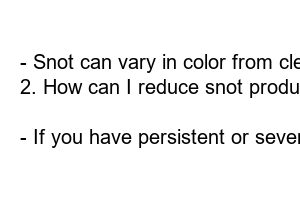코딱지가 자주 생기는 이유
Have you ever wondered why you *constantly* have a runny nose and constantly have to deal with *snot*? Well, you’re not alone. Snot is a common occurrence for many people, and there are several reasons why it happens. In this blog post, we’ll explore some of the main causes of snot and why it often occurs in English.
**What is Snot?**
Snot, also known as nasal mucus, is a viscous substance produced by the mucous membranes in the nose and sinuses. It helps to trap dust, bacteria, and other particles, keeping them from entering the respiratory system.
**Why Does Snot Occur?**
Snot often occurs in English due to a variety of factors, including allergies, colds, sinus infections, and exposure to irritants like pollution or smoke. When the body detects a foreign invader, such as a virus or allergen, it produces more mucus to help flush out the intruder.
**Allergies and Snot**
Allergies are a common cause of snot, as the immune system overreacts to harmless substances like pollen, pet dander, or dust mites. This triggers the release of histamines, which can cause nasal congestion and increased mucus production.
**Colds and Snot**
Colds are another common culprit of snot, as the body’s immune response to the virus leads to inflammation and increased mucus production. This can result in a runny or stuffy nose, sore throat, and coughing.
**Sinus Infections and Snot**
Sinus infections, or sinusitis, occur when the sinuses become inflamed due to a bacterial or viral infection. This can cause nasal congestion, facial pain, and increased mucus production, leading to thick, discolored snot.
**Environmental Factors and Snot**
Exposure to irritants like pollution, smoke, or strong odors can also trigger increased mucus production and snot. The body produces more mucus to help trap and remove these irritants from the nasal passages.
**Summary**
In conclusion, snot often occurs in English due to allergies, colds, sinus infections, and exposure to irritants. The body produces more mucus as a defense mechanism to flush out foreign invaders and keep the respiratory system healthy.
**FAQs**
1. What color should my snot be?
– Snot can vary in color from clear to yellow or green, depending on the underlying cause. Green or yellow snot may indicate an infection.
2. How can I reduce snot production?
– Keeping hydrated, using a humidifier, avoiding allergens, and staying away from irritants can help reduce snot production.
3. When should I see a doctor about my snot?
– If you have persistent or severe nasal symptoms, such as bloody discharge, facial pain, or a high fever, it’s important to see a doctor for proper evaluation and treatment.

